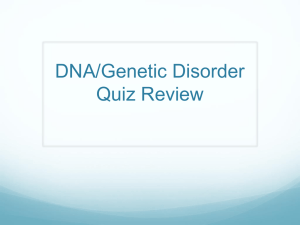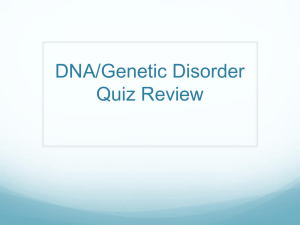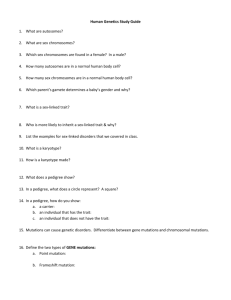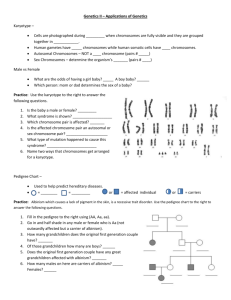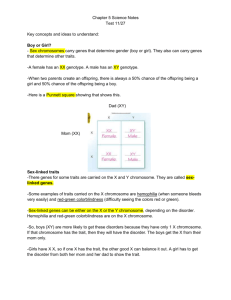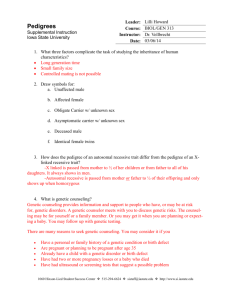chapter 12—inheritance patterns and human genetics
advertisement
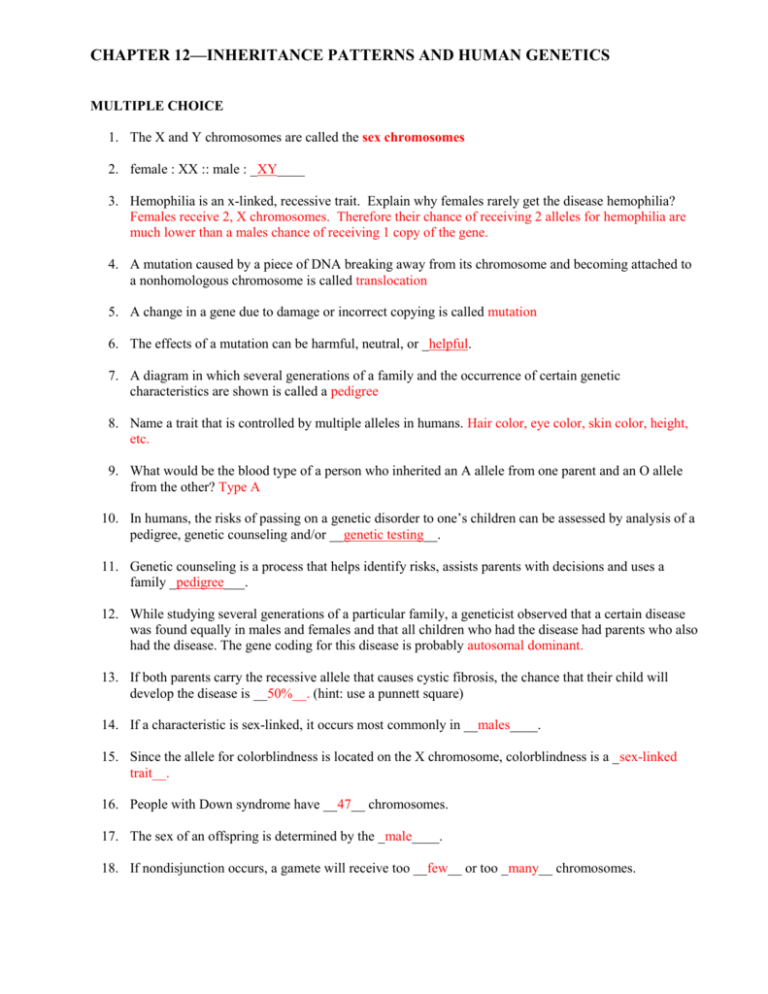
CHAPTER 12—INHERITANCE PATTERNS AND HUMAN GENETICS MULTIPLE CHOICE 1. The X and Y chromosomes are called the sex chromosomes 2. female : XX :: male : _XY____ 3. Hemophilia is an x-linked, recessive trait. Explain why females rarely get the disease hemophilia? Females receive 2, X chromosomes. Therefore their chance of receiving 2 alleles for hemophilia are much lower than a males chance of receiving 1 copy of the gene. 4. A mutation caused by a piece of DNA breaking away from its chromosome and becoming attached to a nonhomologous chromosome is called translocation 5. A change in a gene due to damage or incorrect copying is called mutation 6. The effects of a mutation can be harmful, neutral, or _helpful. 7. A diagram in which several generations of a family and the occurrence of certain genetic characteristics are shown is called a pedigree 8. Name a trait that is controlled by multiple alleles in humans. Hair color, eye color, skin color, height, etc. 9. What would be the blood type of a person who inherited an A allele from one parent and an O allele from the other? Type A 10. In humans, the risks of passing on a genetic disorder to one’s children can be assessed by analysis of a pedigree, genetic counseling and/or __genetic testing__. 11. Genetic counseling is a process that helps identify risks, assists parents with decisions and uses a family _pedigree___. 12. While studying several generations of a particular family, a geneticist observed that a certain disease was found equally in males and females and that all children who had the disease had parents who also had the disease. The gene coding for this disease is probably autosomal dominant. 13. If both parents carry the recessive allele that causes cystic fibrosis, the chance that their child will develop the disease is __50%__. (hint: use a punnett square) 14. If a characteristic is sex-linked, it occurs most commonly in __males____. 15. Since the allele for colorblindness is located on the X chromosome, colorblindness is a _sex-linked trait__. 16. People with Down syndrome have __47__ chromosomes. 17. The sex of an offspring is determined by the _male____. 18. If nondisjunction occurs, a gamete will receive too __few__ or too _many__ chromosomes. 19. In humans, the genotype XX results in a(n) __female___. 20. When traits do not appear according to the expected ratio in offspring, _crossing over_ may have occurred. 21. When a piece of chromosome attaches itself to a nonhomologous chromosome, the resulting mutation is called a(n) _translocation___. 22. A mutation in which remaining codons are grouped incorrectly is called a(n) __frameshift____ mutation. 23. A(n) __sex influenced__ trait is one in which males and females can show different phenotypes even when they have the same genotype. 24. Spontaneous changes in genetic material are called __mutations__. 25. __gene therapy_, in which a defective gene is replaced with a healthy gene, is a treatment being developed for genetic disorders. 26. A person who is heterozygous for a recessive disorder is called a(n) __carrier____. 27. A genetic disorder resulting in defective blood clotting is __hemophilia_. 28. Phenylkenonuria (PKU) is a genetic disease in which an individual lacks a(n) __enzyme___ responsible for converting the amino acid phenylalanine into the amino acid tyrosine. The partially completed pedigree below is for a family with a genetic disorder. 29. Refer to the illustration above. The father listed in the pedigree is most likely _heterozygous_______ for the trait. 30. Refer to the illustration above. Child 3 probably has a(n) __recessive___ phenotype. 31. What is the above diagram called? Pedigree What is it used for? Identify chromosomal issues 32. Looking at the 23rd set of chromosomes, this individual is a __male___. 33. The natural variation in human hair color is due to __many genes (polygenic)__. 34. Study the pedigree above, is the trait autosomal or sex-linked? autosomal 35. 36. Describe each of the above chromosome types. I. Replicated chromosome II. Single chromosome III. Tetrad (homologous set) 37. In humans, cystic fibrosis is caused by a recessive gene that is not sex-linked. A man and a woman, neither of whom has cystic fibrosis, have two children with the disease. What is the probability that their third child will have the disease? Write your answer in the space below. 38.What are the possible genotypes of children born to a man who has the genotype IAi for blood type and a woman who has the genotype IAIB? What are the possible phenotypes? Write your answer in the space below.

